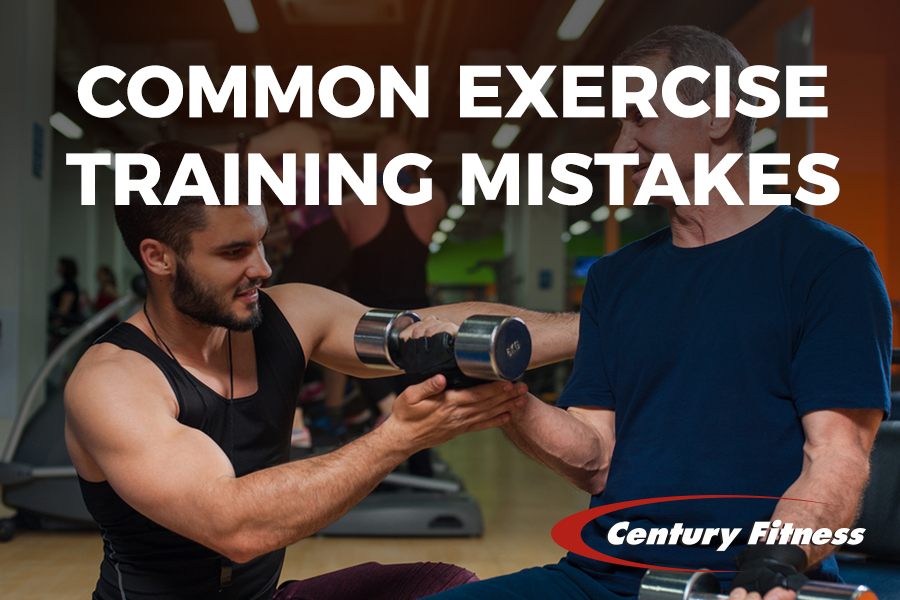Common Exercise Training Mistakes
By your Fitness Trainers at Century Fitness
Written by Paul Dalton, CFit Staff and Personal Trainer
- Improper/lack of warm-up
Adequately preparing your body for activity is an important component of exercise. This is achieved via a warm-up that increases heart rate, body temperature, and blood distribution to the muscles. Be sure to warm-up the entire body as many complex exercises rely on muscle groups additional to its target muscle group (e.g. squats). A proper warm-up can be easily achieved via calisthenics, dynamic stretching, a brief period on the elliptical (e.g. ~5 min), along with other methods. A warm-up shouldn’t take you to the point of sweating, but you should feel a rise in body temperature and heart rate.
- Mimicking other members
We’re always looking for a new way to get a good workout in and it’s important to periodically switch up our workouts to prevent a plateau in progression. However, it’s not always in your best interest to copy exercises done by other members. Form and technique are the most important aspects of every exercise and there is A LOT of poor form in American gyms. Please keep in mind that although an individual seems experienced in what they’re doing, it doesn’t mean it is being done correctly or that it’s right for you. Exercise training that is consistent and intense enough will elicit adaptations that can be seen externally, even if the exercise isn’t performed correctly. When interested in an exercise another member is performing, ask a fitness professional or research proper form and technique for that exercise prior to trying it on your own. When referring to the internet (e.g. YouTube) for proper form and technique, be careful as there are a lot of supposed “experts” posting videos with incorrect instruction.
- Bouncing bar off the chest during barbell bench press
This habit greatly increases chances of injuring the sternum and is often done due to the greater difficulty of the repetition at the deepest point of contraction. When barbell bench pressing, be sure to touch the bar to the chest, but maintain enough control to prevent any bouncing. This control will require more strength and provides a greater stimulus for adaptation when done compared to exploiting the elastic properties of the chest’s connective tissue. If you’re struggling with changing this habit even after reducing the load, try stopping before touching the bar to your chest to develop strength through that range of the contraction before risking a bounce by lowering the bar further.
- Reduced time-under-tension
Few individuals enjoy the sensation of the grind mid-repetition, as a result many complete each repetition as quickly as possible, regardless of their training goals. Completing each phase of the contraction (eccentric/weight-lowering phase & concentric/weight-lifting phase) for each repetition as quickly as possible has shown to be more beneficial for power-based training goals, while strength-based training goals are improved by spending about 1 – 2 seconds in each contraction phase of every repetition.
- Uncontrolled/monitored rest between sets
Rest between sets plays a big part in the intensity of the stimulus to adapt provided by exercise. Too little rest may induce adaptations specific to a different training goal, while too much rest may make the next bout too easy for any adaptations to occur! Be sure to not get carried away with conversation and keep an eye on how long you allow your body to recover between sets.
- No cool-down
Coming to a sudden stop from driving at a high speed isn’t good for your car, neither is it good for the body. A gradual regression in activity intensity is protective of the heart compared to a sudden cessation. Changing heart rate is one of the most challenging and costly actions the heart can perform. Cool-downs allow for a smaller change in heart rate and allow ample time for adequate post-exercise blood redistribution compared to suddenly stopping.
- Steam room/sauna (external heating) post-exercise
Temperature is one of the two major threats to the body’s internal environment and is greatly elevated by exercise for as long as 48 hours post-exercise (depending on exercise type)! At the end of exercise, the body is fighting to return blood and tissue temperature back to normal. By entering environments that provide additional heat the cardiovascular system is placed under additional thermal strain. This increases the work of the heart and level of dehydration due to sweat loss, impairing post-exercise recovery. Nonetheless, the use of saunas and steam rooms has its benefits, such as the release of toxins through sweat.
- Post-exercise nutrition
Muscle protein synthesis has shown to be maximized when protein is consumed within 15 minutes of the end of the work out. In fact, recent studies show that if enough protein is ingested, then the addition of carbohydrates will not further augment post-exercise muscle protein synthesis, though it is still beneficial to consume carbohydrates at this point to replenish intramuscular glycogen stores, especially for athletes.
This article is intended to provide general knowledge of health and fitness principles and should not be taken as medical advice or used to diagnose health problems or for treatment purposes. It is not a substitute for medical care provided by a licensed and qualified health professional. Always consult your doctor or licensed healthcare provider for personalized advice on diet and exercise.


Recent Comments